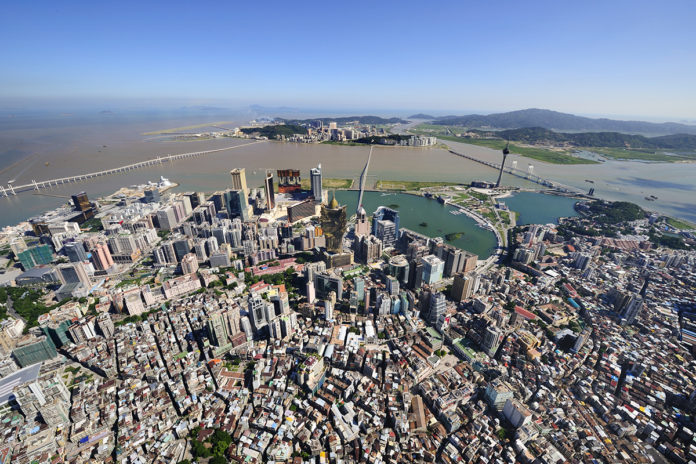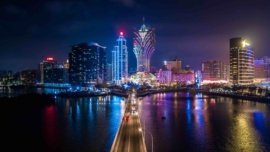The liberalisation of the gaming sector reshaped Macau and has forever changed the city’s landscape By Sara Farr Physical changes are inevitable in any city pursuing growth and international renown. But the changes that have occurred in Macau and to its skyline since the liberalisation of the gaming sector have been not so much evolutionary as revolutionary. Taking a stroll down memory lane, where once was an unturfed football pitch, now sits the 58-storey Grand Lisboa. Where City of Dreams now stands, there was little more than a swamp. Macau had 11 casinos in 2002. It now has triple that number. There are not just more of them, but they are also bigger and architecturally more sophisticated. The change in the city’s physical appearance brought about by the liberalisation of the gaming sector was not simply the result of more casinos rising from the ground. As the economy has boomed, fuelled by the gaming industry’s performance, high-end residential buildings have mushroomed, intended for foreign investors, resident expatriates and a wealthier set of locals. In a city that once had no luxurious high-rise apartments, the likes of La Cité in Areia Preta, One Central in the city centre and One Grantai in Cotai have reshaped the market. The government has also played a role in the transformation. With a fat public purse fed by taxes on gaming revenues, it has commissioned big projects such as the Macao Science Centre and the Taipa ferry terminal. Macau now covers an area 15 percent bigger than in it did in 2001. Cotai has almost doubled in size from 3.5 sq km to 6 sq km. The southern part of the peninsula, where the first phase of post-liberalisation casino building took place, has also grown by 0.5 sq km. American casino architect Paul Steelman is one of the influences behind the changes in the city’s skyline. He has worked on a number of projects, including the first casino to break Stanley Ho Hung Sun’s four-decade-long monopoly, the Sands Macao. A clear view The architect’s firm, Steelman Partners LLP, has also been involved in StarWorld, City of Dreams, Casino Oceanus, the Plaza Macao and, more recently, Galaxy Macau. “It has been an incredible journey,” Mr Steelman says. “When we started designing the Macau resorts, modern architecture was being planned everywhere. Modern, state-of-the-art architectural design was in vogue.” He believes Macau has resurrected the themed resort. “The theme is back,” he says. He considers Galaxy and the Venetian to be the most popular casino resorts here. He emphasises that a “scientific approach” to interior design is needed to keep customers coming back regularly. It takes a while to determine if an ordinary building is successful, he says. “Casino resorts are judged in five minutes.” Fantasy architecture, as Mr Steelman calls it, has contributed to the success of casino resorts in Macau. “The maverick design attitude of all of the casino owners has created diversity and fun.” In one decade, casino design in Macau has clearly evolved. Compare Galaxy Macau, which opened less than a year ago, to some of its more mature partners. It is much brighter inside, thanks partly to research findings that mainland players prefer a clear view of what is happening on the table. Mr Steelman says that from day one his firm studied the market – staff and customers alike – so it could “design the best gaming solution”. Knowing that a copy of Las Vegas was not going to work in Asia, the company has tried to explore new ideas and come up with new designs. High rise Panoramic views of the city, whether from the top of Macau Tower or Big Taipa Hill, have changed beyond recognition in the past 10 years. Macau’s skyline is now among the best in the world, according to Emporis, an international property database. Macau is 22nd on a list that ranks cities by the number of high-rise buildings it has and their height. Not all agree that the transformation has been for the better. “Those gigantic casino buildings disharmonised the environment with Macau’s original buildings,” says Ben Leong Chong In, the president of the Architects Association of Macau. He says foreign architects have shown little consideration for the city’s culture and landscape, and failed by not creating sufficient buffer zones between the old and the new. Several architects told Macau Business that the government’s urban planning should have struck a better balance between the casino boom and what came before it. “There’s very poor ventilation in the Inner Harbour, for example. Look at the mammoth casino there,” says local architect Francisco Vizeu Pinheiro, pointing at the Ponte 16 casino resort. Mr Vizeu Pinheiro says Macau not only needs an urban plan but also feasible ideas that would really work for the city. “While places such as Singapore have good buildings, expensive designs that work for that city, Macau does it based on what’s cheaper,” he says. Singapore has been praised internationally for successfully combining casino legalisation with urban renewal, with the Marina Bay Sands casino resort as the cornerstone. Lack of respect In Macau, the most distinctive building to have sprouted since liberalisation is arguably the lotus-shaped Grand Lisboa. Last year CNNGo, a travel and lifestyle website produced by CNN, chose the Grand Lisboa as one of the 20 most iconic skyscrapers in the world. Mr Pinheiro says it is important to take into account what neighbouring cities are doing without imitating them. “Observe, learn from it and not simply copy it,” he says. Mr Leong says it is quite possible to come up with a coherent plan for integrating the casinos and the rest of the city in a sustainable manner. “I believe that the key to this issue is to pay enough respect to the city’s culture and its environment and spatial organisation,” he says. Liberalisation is also gradually moving Macau’s economic heart from the peninsula to Cotai. Researchers at investment bank J.P. Morgan believe the Cotai Strip will be the new centre of Macau’s gaming industry. All new casinos in the pipeline will be there. “There’s been visible changes along the Strip,” says architect Maria José de Freitas. Despite a lot of talk from the government, Ms Freitas says little was done to ensure the sustainability of developments there. “A lot could have been done,” she says.
—
























